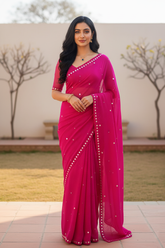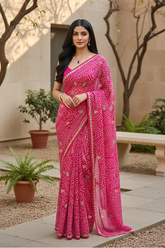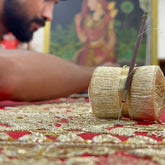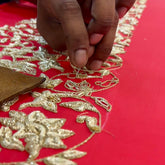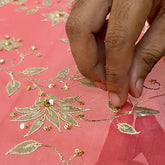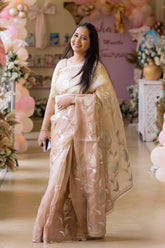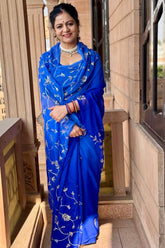Zardosi – The Queen of Embroidery
Introduction: Where Gold Meets Grace
Among India’s most resplendent embroidery legacies, Zardosi stands as a shimmering testament to royal grandeur and masterful craftsmanship. More than a technique, it is an emotion stitched in gold and silver — a dialogue between the past and present, between opulence and devotion.
From its origins in Persian courts to its flourishing under Mughal patronage, Zardosi has evolved into one of India’s most enduring crafts. Today, it finds new life through dedicated artisans and visionaries like Gaj Singh Bhati, whose work at Umaid Couture bridges heritage and modern design with quiet reverence.
Each Zardosi stitch — a dialogue between hand, metal, and imagination.
The Origins — From Persia to the Splendour of the Mughal Courts
The term Zardosi comes from the Persian words zar (gold) and dozi (sewing), literally meaning gold embroidery. This craft journeyed to India through cultural exchanges with Persia and reached its zenith under the Mughal emperors, especially Akbar, in the 16th century.
In the royal ateliers, gold and silver threads adorned court garments, ceremonial textiles, tents, and even royal animal trappings. Zardosi was not just art — it was status, sanctity, and spectacle.
Over time, Indian artisans infused this foreign art with native motifs — lotus, peacock, mango (ambi) and architectural geometry — transforming Zardosi into a uniquely Indian expression of beauty and devotion.
Under Mughal patronage, Zardosi adorned emperors, queens, and royal courts.
The Technique — When Threads Become Gold
Every piece of Zardosi begins with an adda, a wooden frame that stretches the fabric — silk, velvet, or satin — for tension and precision. The design is traced, and then begins the layering of brilliance.
H3: The Process of Crafting Zardosi
-
Tracing: The design is drawn or transferred onto the fabric using chalk or perforated patterns.
-
Laying the Metal Threads: Gold- or silver-plated wires (badla) are placed over the design lines.
-
Couching & Fixation: The threads are secured with fine silk thread in meticulous stitches.
-
Embossing & Embellishment: Using coils (dabka), spirals (salma), beads, pearls, or sequins, artisans create raised effects and textures that catch the light.
Each stitch is deliberate. A single motif can take hours — a saree or lehenga, weeks. The craft thrives on patience, precision, and deep meditative rhythm.
The hallmark of Zardosi — metallic threads layered in relief, sculpted by hand.
H2: The Cultural Heartbeat — From Palaces to Celebrations
Historically, Zardosi was the language of royalty. Kings and queens wore it to proclaim their stature; temples draped it on sacred idols. Over centuries, it became woven into India’s cultural identity — adorning bridal wear, ceremonial textiles, and heirloom attire.
Today, Zardosi continues to symbolize blessing and prosperity. In Indian weddings, it stands for the union of tradition and grandeur. The golden embroidery gleaming under soft light still evokes the same reverence it did centuries ago.

H2: Adaptation and Evolution — The Craft That Refused to Fade
When colonial trade policies and machine-made textiles threatened handmade arts, Zardosi nearly disappeared. Yet, its custodians — generations of artisans — adapted and endured.
Clusters across Lucknow, Bareilly, Hyderabad, and Bhopal preserved the tradition, each developing distinct regional nuances. Lighter threads, affordable materials, and minimal motifs gave Zardosi new versatility, making it accessible to more people while keeping its royal allure intact.
Today, Zardosi has expanded beyond bridal couture to accessories, shawls, home décor, and couture detailing, proving that luxury can evolve without losing soul.
From royal robes to modern couture — Zardosi continues to evolve with grace.
H2: Umaid Couture and Gaj Singh Bhati — Preserving the Golden Heritage
While much of the world rushes toward mechanized perfection, some choose to pause — to preserve the human touch. At Umaid Couture, designer Gaj Singh Bhati embodies this philosophy. His vision goes beyond fashion — it is about safeguarding a living heritage.
Through collaborations with master artisans, Umaid Couture reinterprets Zardosi with purity of technique and modern relevance. Every saree, shawl, and garment crafted here is a continuation of a centuries-old story — where art is not replicated, but reborn.
At Umaid Couture, Zardosi lives — refined, revered, and reimagined.

Bhati’s efforts ensure that the art doesn’t fade into nostalgia but evolves responsibly. His workshops focus on fair wages, sustainable materials, and design education — nurturing the next generation of Zardosi masters while keeping the soul of the craft untouched.
H2: Challenges and the Road Ahead
The challenges are real:
-
Rising cost of gold and silver threads
-
Competition from machine-made imitations
-
Younger artisans migrating to other industries
Yet, optimism shines through renewed appreciation for handmade excellence. Initiatives like Lucknow Zardosi’s GI status, government craft programs, and global couture platforms have reignited interest in authentic craftsmanship.
Zardosi today stands at a hopeful crossroads — one where revival meets reinvention.
H2: Conclusion — The Eternal Gold Thread of Indian Artistry
Zardosi is more than embroidery; it is poetry in metal and silk — a golden testament to India’s cultural soul. From Persian courts to Mughal ateliers, from royal wardrobes to the collections of Umaid Couture, its journey remains unbroken.
Each thread carries the memory of empires and artisans; each shimmer reflects devotion and pride. Through the hands of those who still believe in its magic — and through the mindful work of Gaj Singh Bhati — Zardosi continues to shine, not as a relic of the past, but as a luminous promise for the future.
Zardosi — the eternal gold thread that binds heritage with modern grace.

